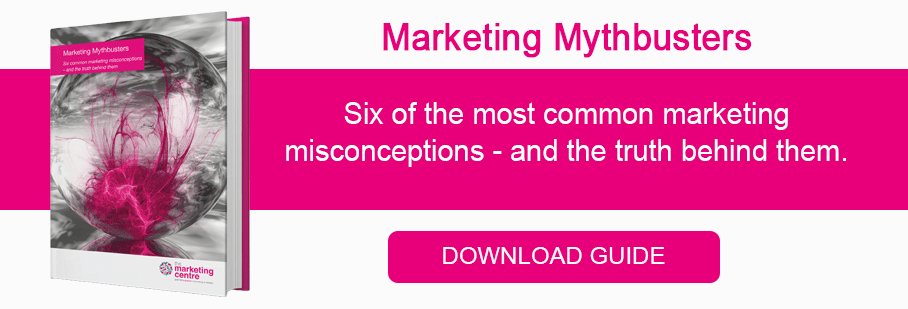Introduction
The world is full of myths, from fake news to faux facts. Mount Everest is not the world’s tallest mountain, The Great Wall of China can’t be seen from space, and the word “sushi” does not mean “raw fish”. (It’s the vinegared rice on which the fish was traditionally served, and it’s spread to mean the sour taste of the rice - so it describes the flavour of the dishes, not the dishes themselves.)
Marketing is no different. Our field is laden with misunderstandings and misconceptions. Quite a few of them originate with marketers - or at least with self-proclaimed experts who don’t have the credentials, experience or clarity to support their claims. They peddle their nonsense to business owners who aren’t clear about the role marketing plays in their business, they pass those ideas on to their peers, and the myths just keep on spreading.
A proven, experienced part-time Marketing Director has built up the meaningful insights and practical experience necessary to spot and dispel these myths. Our Directors have come together, identified the six most widespread and consistent marketing myths they’ve encountered time and time again - and explained exactly why they’re wrong, untrue or simply the result of a misunderstanding.
We’re here to prove that marketing isn’t just about lead generation, or brilliant ideas; that marketing isn’t an unnecessary cost; that not anyone can do PR; that you can, in fact, measure ROI in digital marketing, and that marketing content is not as easy as it looks.
Shortcuts
- Myth #1 - Marketing is all about lead generation
- Myth #2 - Marketing is all about brilliant ideas
- Myth #3 - Marketing is an unnecessary business cost
- Myth #4 - Anyone can do Public Relations
- Myth #5 - You can’t measure ROI in digital marketing
- Myth #6 - Writing good marketing content is easy
Myth #1 - Marketing is all about lead generation
People like to say marketing is all about leads. It’s easy to see how this one got started. New leads mean more business, and lead generation is marketing’s job.
But lead generation is not marketing’s only job. Marketing teams also have to warm up those leads, qualifying them and making them ready for sales professionals to step in. Marketing is about brand, employer brand, research, positioning, customer service - to be frank, almost everything your business does. If that additional work isn’t done with marketing in mind, 71% of the generated leads end up going to waste.
Basically: you need to know what you’re looking for before you go looking for it. Your marketing team need to establish a value proposition (what you’re selling), target segments (who you’re selling it to) and their pain points (why they want to buy it).
So what do marketers do to ensure the leads they generate are useful?
The truth
Our Marketing 360 framework establishes four fundamental functions that marketing performs within a business: it can define, find, win and keep customers. Each of those functions has to be carried out at three levels: strategic, operational and support (the plan, what you do, and how you ensure you’re doing it well). Lead generation occupies only one point on that grid - finding at the strategic tier - and even then, it fits into an overall process. We’ll take you through this process step by step.
Define: establish your brand
Who is the customer? What do they need? What can you actually do to fulfil those needs? Answering those questions means you’re ready to establish your messaging (how you tell people your product or service can do what they need) and the culture within your company (how you go about proving it). This stage informs everything else you do, at every level, including the next stage in the strategic chain.
Find: generate your leads
Finding customers? That’s lead generation. Whether you’re in B2B or B2C, you need to establish what your potential customers have in common, which communication channels they use, and which routes to market they’re likely to take once they’ve heard your message. This informs your operational level (the specific things you do to generate leads) and support level (identifying and sourcing technology to support your business’ growth).
Win: align your sales team
At a strategic level, this is about the tools and messages that move your customers along their journey, and that identify the accounts the sales team need to target as a matter of priority. This is sales alignment - the process by which you make sure your sales and marketing personnel both understand their roles in converting a customer, and know when a customer becomes sales’ responsibility.
Keep: retain your customers
Customer retention is the final stage in the strategic chain that leads into and through lead generation. This is where you identify the specific marketing activities and after-sales care that will keep customers on board, and the opportunities for cross-selling and upselling. It’s also where you engage in dialogue with your customers and let their feedback inform your decisions at a strategic level, adjusting operations and support where necessary.
All of these functions have an equal weight within your marketing strategy, and inform the operational and support activities that put that strategy into practice. Marketing takes in the entire 360 - the setting, testing and analysis of marketing plans, establishing of processes and segmenting audiences for better targeting. It’s an ongoing process that you’ll always be improving throughout your time as a business leader - and it’s about so much more than generating leads.
Myth #2 - Marketing is all about brilliant ideas
Many business leaders see marketing as nothing but big ideas - catchphrases, gimmicks and hashtags - that can unlock business gains all by themselves. If the brilliant idea catches on, goes viral, and wins awards, they think, everything will turn out fine. And so they treat marketing as all brainstorming and no planning, looking for “ideas people” who can come up with something crazy and creative in every meeting.
As non-marketers, they think about their favourite ad campaigns - the ones that become part of popular culture, like “should have gone to Specsavers” - and think the slogan’s the only thing that matters.
The truth
Innovative ideas are only part of the process. You need a healthy blend of inspiration, execution and measurement to make a marketing plan that gets results. The creative talent has to fit within a wider marketing plan that relies on proven methods to achieve specific business goals. The essence of a marketing plan includes:
-
Objective (what you’re trying to achieve)
-
Strategy (the approaches you’ll use to achieve it)
-
Execution (the creative material that you’ll use to enact the strategy)
-
Testing (reviewing the execution to see if it’s achieving the objectives)
-
Adjustment (doing more of what works and less of what doesn’t)
Testing on a small scale is extremely easy, especially with digital marketing. Tools like targeted social media advertising or A/B testing landing page performance or calls to action mean you can tweak, measure and adjust marketing material on a daily basis - and make your decisions based on data rather than bright ideas.
For moments of inspiration to serve your business goals, they need to fit into a broader and deeper marketing process. You need to emphasise your business’ goals and budget, and the audience’s preferences and desires, and then start workshopping ideas that align with those essential elements. Once the ideas are executed, you need continuous testing, measurement and analysis to improve their effectiveness - and their return on investment - as you find out what really makes your audience tick.
Myth #3 - Marketing is an unnecessary business cost
Most businesses are aware that they need some sort of marketing activity to keep up with their competitors, but they’re not sure what Return On Investment their marketing actually provides. And here’s the thing: marketing is expensive.
There are salaries for marketing directors and managers; there’s spend on third parties like content creators, SEO consultants, brand designers, researchers and PR professionals; and then there’s Customer Relationship Management software, website redesigns, event stands, the bills for Pay-Per-Click advertising… everything you do to bring customers into your business and keep them there is, ultimately, marketing.
Marketing spend can really start to mount up, and without a clear way to link spend and profit through measurable outcomes, you can end up believing marketing is a waste of money.
The truth
Marketing is an investment. It should earn you more than you spend, and what it earns you should be measurable in monetary terms.
Marketing consultants and agencies often feed the myth by using vanity stats to justify their work. They say things like “we’ve had twelve million impressions, two thousand shares, five influencers have talked about it and we’ve won an award.” This is all well and good, but it if doesn’t lead to an actual increase in profits, what does it matter?
Your marketing spend is justified by its impact on specific business goals - a set number of customers spending money. Therefore, the very first conversation you have with your marketing director should be about what success looks like, and what investment is necessary to get there. Start with the end of the process and work your way along:
-
How much does each customer spend over their lifetime?
-
How many leads does it take to secure each sale?
-
How many contacts need to be gathered to generate one lead?
-
How much web traffic did it take to secure that many contacts?
-
How much does it cost to create content that brings in that much traffic?
That conversation defines the Return you’re looking for and the Investment you’re making to get there - and that’s how you know your marketing spend isn’t money down the drain. If your marketing director starts talking about digital, social, trends and stats before they work through these questions, they’re dealing in myths.
Myth #4 - Anyone can do Public Relations
“Public Relations” is one of the most misunderstood aspects of marketing. Those two words call up an immediate picture; spin doctors schmoozing over long lunches, ‘networking’ endlessly and telling each other lies. It’s expensive, it promises more than it delivers, and it basically comes down to writing a few press releases and boozing it up with journalists.
The truth
PR’s bad reputation dates back to the heady days of mid-Eighties marketing - insane budgets and no accountability. The industry is more professional, organised and responsible than it used to be, and goes a long way beyond press releases.
PR takes in developing the key messages, segmenting the target audience, and smart targeting with the right materials. PR teams are responsible for event support, speaker placements, award entries, analyst relations and crisis management - any point of contact with the public is part of their remit. PR is nuanced, responsive, and always on. In other words - it’s a full-time responsibility which you can’t afford to assign to anyone who wants a long lunch break.
No amount of PR can completely control what is said or written about your brand, but good PR shines a positive light on the good work you do and the specific accomplishments you’ve achieved, increasing your brand visibility and brand equity.
Like the rest of your marketing activities, PR can show ROI, as long as clear business goals are set. If you’re trying to grow your presence on social media, then analytic tools like Brandwatch can monitor activity and count every mention of your brand online. If you’re trying to drive traffic to your website, you can analyse backlinks (the sites that link to yours and lead potential customers to click through).
For SMEs, PR is often a cost-effective way of creating and building relationships with customers. It can carry more impact and credibility than advertising - which is pure promotion, rather than a dialogue with trusted figures. PR can also position brands within their sector, highlighting unique selling points that differentiate them from the competition.
Ultimately, PR is all about reputation. It’s about taking charge of your brand’s story - steering the conversation around your brand so you can share your successes and address your failings.
Myth #5 - You can’t measure ROI in digital marketing
It takes in Search Engine Optimisation, websites, social media, email newsletters and mobile apps. It’s broad, it’s complicated, and it often demands dedicated personnel with specialist skills and experience.
Often, these digital specialists aren’t marketing strategists - which means they tend to view ROI on their own terms. If their work is getting views, likes and shares, i.e. performing well in the digital space and on digital terms, their work here is done. Impact on the bottom line? That’s not digital business. They’re all about reach, engagement and stats.
The truth
Marketing goes beyond communications. It’s a series of core principles that define your business and offering. It touches every aspect of your business and it’s fundamentally concerned with investment and returns - even in the abstract realm of the Internet.
To be fair, it’s not easy to establish the ROI of digital marketing activity. The customer journey is complex, especially when prospects encounter your brand through multiple digital channels before they decide to engage.

Marketing software can track, analyse and predict user activities - monitoring backlinks, bounce rates and clicks on your own website - but this detailed journey mapping isn’t the only way to measure marketing ROI. Businesses without the budget for an expensive software package can instead focus on two essential metrics that indicate digital marketing ROI:
-
Divide your sales income by your digital marketing spend and you’ll be able to express marketing as a percentage of sales. Ideally, you should be spending 4-8% of your sales income on marketing activity, rising into the low double figures if you have a new product to push or a new target market you want to break. This figure gives some clarity by showing how much of your return is being churned back as investment.
-
Divide your digital marketing spend by the number of customers you’ve acquired and you’ll have your cost per acquisition (CPA). The ideal figure is fairly low - but ‘fairly low’ will vary depending on how many customers you have and how much they are worth. If your average customer is worth £500k over a five year contract, it’s worth spending £50k on acquiring them.
For greater clarity, you can look at customer retention metrics. Your chance of making a new sale to an existing customer is around 60-70%, compared to 5% for a newly generated lead. Track your customer lifetime value (the average amount each customer spends while they’re still buying from you), churn rate (the turnover of customers who stop buying each month) and customer retention cost (spend on specific retention-focused activities like after-sales care, divided by the number of customers successfully retained).
You’ll notice that none of these figures involve the things that get digital professionals excited - there’s no talk here of impressions or reach or engagement. That’s deliberate. Don’t get lost in the digital details: focus on what you’re spending and what you’re making. Follow the money and you’ll find your ROI.
Myth #6 - Writing good marketing content is easy
Content is the marketing collateral you create for your business that isn’t advertising, press releases or internal brand-building communications.
How do customers decide to buy? They look at your website. They read your blog. They watch your videos. They might have checked out your social media channels, subscribed to your newsletter, maybe even downloaded your ebook. Basically: they interact with your content.
Content is hugely important - but too many businesses believe they can post any old guff. A few hundred words a week about a product, a project, or a special offer. Nothing interesting happening? Skip a week. No budget? Have the interns do it. It’s certainly not anything the C-suite need to trouble themselves with - right?
The truth
It’s true: you can actually post any old guff. But effective content that actually brings customers in and gets them to convert? That isn’t easy, it isn’t fast, and it isn’t cheap. It takes an average of 14 hours to produce one piece of short-form content like a blog post, bringing it from concept to publishing. Those 14 hours have to coexist with all your everyday business operations, so they’re generally spread out across around 12 actual days.
Good content takes this span of time because it has to be well written, offer genuine and useful insight, and be targeted with laser-like precision to the specific audience you want it to reach. That takes research, skill, and redrafting.
Bad content may go up quickly and at little cost, but picture this. Your company blog is basically navel-gazing that offers no value to the reader, is littered with spelling mistakes, and every post has a chain of unanswered comments from unsatisfied customers. It’s damaging your brand equity merely by existing.
So, what does good look like? Good content is:
-
Audience-led. Your business exists to solve a problem for your customers. Your content should aim to tell them that. Focus on their pain points. Everything you publish should be useful to people who don’t work for you.
-
Aligned with your brand. Whatever your brand’s mission, vision and values may be, your content should extend them. Same tone of voice, same aesthetic, and providing evidence that your claims are followed up by actions in your everyday operations.
-
Comprehensively planned. Map out the key points you want to make; research each one; add stats, facts, figures and experiences that prove them. And stay on topic - focus every word of every article on the topic and theme.
-
Aiming for excellence, not perfection. Perfectionism leads to inertia and nothing gets done. It’s more important that content comes out on a regular schedule, and that you’re agile enough to respond to a bad review or a breakout tweet when it happens.
-
Outsourced. Our in-house survey showed that 85% of people - business leaders included - think they’re a better writer than average. Mathematically, that can’t be true. It’s easy to tap away at a keyboard and get something down eventually, but a good content agency will provide writing talent, strategic guidance and an editorial calendar that gets the most out of your time.
The words, images and videos on your website are always working for you, long after your sales and marketing team have clocked out for the night. Beyond that, the process of creating content helps you define how your business speaks, behaves and thinks. It’s helpful, it’s useful, but it takes time - and people can spot a rush job a mile away. Take the time, spend the money, and do it properly.
Conclusion
Marketing is plagued by mythology. While some of it comes from malicious actors trying to sell themselves as something they’re not, the majority is rooted in simple misunderstandings. And that’s fine - not everyone is or can be a marketing professional. The real key to busting these myths is recognising that you don’t have to be.
As a business leader, you need to know enough about marketing to tell the good advice from the bad; you need the simple, direct accounts of Return On Investment that prove your marketing spend is paying off.
You need to recognise that marketing is not just lead generation, but a process that draws on and feeds into operations, support and overall business strategy.
You need to understand that a brilliant slogan, hashtag or graphic is one tiny, tiny part of a well-tuned, targeted, tested marketing plan.
You need to know that customers are on a journey, and each marketing activity should lead them closer to the point of sale - even if the route they take isn’t direct.
You need to forget about PR as glorified schmoozing with the press, and embrace it as a constant process of dialogue with the people who tell the world what your business is about.
You need to bypass the digital demagogues and cut to the chase - what are you spending on digital marketing, as a percentage of earnings, and is it enough or too much?
You need to accept that anyone can bang out 500 words on a train - but marketing content is more than just a word count and a deadline.
But when it comes to the details, what you really need is a marketing director you can trust.





